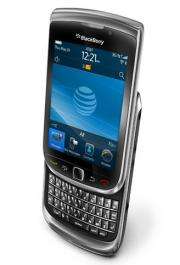BlackBerry Torch no challenger to Android, iPhone

Research In Motion, which has specialized in making messaging-friendly devices with physical keyboards, has struggled to come up with an answer to touch-screen devices such as Apple's iPhone and HTC's Droid Incredible.
Over the past two years, the company introduced two successive touch-screen BlackBerry phones: the Storm and the Storm 2. Both phones represented a radical change for RIM. Neither Storm has a full keyboard, and neither includes a pointing device like the track balls and track pads that are found on other BlackBerry phones. Instead, users select links or position their cursor with their fingers and use a virtual on-screen keyboard to type.
Unfortunately, the BlackBerry operating system and applications often haven't been optimized for touch interaction; clicking can be difficult. And the Storms' screens depress when you tap or type on them, giving a strange sensation that many users dislike. Not surprisingly, both drew mixed reviews, and neither saw big sales.
Now the company is trying again. Earlier this month, RIM released the Torch, a new touch-screen phone that represents something of a return to roots for the company.
Unlike the Storms, the Torch has a full physical keyboard you can access by sliding its screen up. While the keys on the keyboard depress when you touch them, the Torch's screen thankfully doesn't. The Torch also has a touch pad you can use to scroll through a screen or select links instead of tapping on them.
RIM took other steps as well to make the Torch better than the Storms. The device is the first to run BlackBerry 6, a revamped version of the company's operating system. The software includes a new Web browser that's based on the same code as those in the iPhone and in Android phones. The new browser fixes one of the biggest problems with the BlackBerry platform -- its old browser was all but unusable for viewing standard Web pages.
The new software has an interface that's much easier to use with a touch screen, with trays and notification areas that you hide or reveal by dragging up and down. It also helps you group your applications into different screens, including one for media applications and another for those you've downloaded from the company's application store.
RIM also added social networking and multimedia functions to the Torch. A new "Social Feeds" application allows users to see recent posts from contacts on Facebook and Twitter in one place. You can also use the application to post messages to multiple networks.
And the company updated the media player in BlackBerry 6; thanks to that, the Torch's media player will display album art when playing music.
I've never been a big BlackBerry fan, and I hated the Storms. But I generally liked the Torch. The new interface and software work well. Although it's still not as elegant as the iPhone operating system or as functional as Android, BlackBerry 6 helps narrow the chasm between those platforms and RIM's.
Thanks to that, the Torch is much easier, more pleasurable and less frustrating to use than the Storms. Its touch pad in particular came in handy because there are still certain setting screens and applications that are all but impossible to use without it.
But even with the improvements, the Torch in many ways doesn't compare well with the iPhone 4 or the latest Android devices. Its Web browser, for example, was disappointing; it loaded pages haltingly, and it often took time to resolve text images after I zoomed in on them.
Unlike the iPhone 4 or the HTC Evo 4G, the Torch doesn't have a forward-facing camera, so you can't easily use it for video conferencing. And unlike the latest Android devices, it doesn't support Adobe's Flash technology, which is used widely on the Web for displaying video and multimedia.
But the biggest problem could be the relative dearth of applications for the BlackBerry platform. RIM says users can choose from some 9,000 applications in its App World store. But that's a far cry from the more than 200,000 applications available for the iPhone and the tens of thousands available for Android.
Although you'll find some of the top apps, such as Facebook, Twitter and YouTube, preinstalled, you'll be hard-pressed to find others. Some of my favorites, such as Hulu Plus, Internet radio application Pandora and Hipstamatic, a camera application, aren't available for the Torch.
And don't get me started on the games for the BlackBerry. Even the best ones feature graphics and game play that look amateurish and unsophisticated. They're no match even for the ones I downloaded two years ago for my iPhone 3G.
RIM has come a long way with the Torch. But it still has a long way to go if it wants to compete with the iPhone and Android devices. And that's something it'll have to do if it wants to remain in the top tier of the smart-phone world.
___
RIM BLACKBERRY TORCH:
• Troy's rating: 3.5 (Out of 5)
• Likes: Revamped, easier-to-use interface; modern Web browser; good mix of touch-screen and traditional BlackBerry interface
• Dislikes: Few applications; some screens and menus still aren't designed for touch; slow browser
• How much: $199 with a two-year contract from AT&T
(c) 2010, San Jose Mercury News (San Jose, Calif.).
Distributed by McClatchy-Tribune Information Services.





















